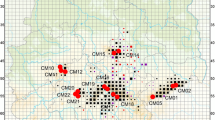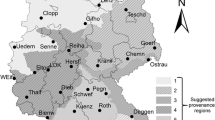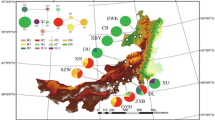Abstract
Land-use conversion and habitat loss and degradation are among the factors affecting populations and species genetic integrity. Understanding how these factors govern the genetic structure of threatened plant populations is essential to design efficient conservation strategies. Here we analyze how environmental correlates, geographic location and anthropogenic disturbance (at local, landscape and regional scales) relate to population differentiation and genetic diversity of a keystone semiarid long-lived shrub, Ziziphus lotus. The European range of this species is restricted mainly to the southeast of the Iberian Peninsula (> 90%) but its area has shrunk considerably as a consequence of intensive agriculture and urban expansion since the 1950s. We characterize its genetic diversity and structure across the Iberian Peninsula with microsatellite markers, considering 21 populations. All populations showed high and relatively similar values of genetic diversity (mean/pop: Ho = 0.54; He = 0.55; AR = 3.59). Three main genetic clusters were defined by clustering analyses corresponding largely to west, central (core) and east of its distribution. Molecular variance analysis revealed that 87.3% of genetic variation was grouped within populations, 5% among populations and 7% between regions. Geographic location (37.88%) has stronger correlation with population genetic differences than landscape characteristics (5.82%). Natural habitat cover at the landscape level was the only environmental variable associated with FST population differences. The detected population genetic patterns are probably related primarily to historical gene flow and secondarily to intensive land-use change of this area in the last 60 years. Our results suggest that, although the long-lived and resprouting strategy of the species is buffering the erosion of genetic diversity at population and regional level, there are already genetic consequences of landscape degradation, which could be aggravated in the future.





Similar content being viewed by others
References
Aguilar R, Quesada M, Ashworth L, Herrerias-Diego Y, Lobo J (2008) Genetic consequences of habitat fragmentation in plant populations: susceptible signals in plant traits and methodological approaches. Mol Ecol 17:5177–5188
Anon (1992) Directive 92/43 of the council of the European community on the conservation of habitats and wild fauna and flora. European Community, Brussels
Aparicio A, Hampe A, Fernández-Carrillo L, Albaladejo RG (2012) Fragmentation and comparative genetic structure of four mediterranean woody species: complex interactions between life history traits and the landscape context. Divers Distrib 18:226–235
Arnaud-Haond S, Teixeira S, Massa S, Billot C, Saenger P, Coupland G, Duarte CM, Serrão A (2006) Genetic structure at range edge: low diversity and high inbreeding in Southeast Asian mangrove (Avicennia marina) populations. Mol Ecol 15:3515–3525
Balkenhol N, Cushman S, Storfer A, Waits L (2016) Landscape genetics: concepts, methods, applications. Wiley, New Jersey
Bermejo D, Cáceres F, Moreira JM (2011) Medio siglo de cambios en la evolución de usos del suelo en Andalucía 1956–2007. Consejería de Medio Ambiente, Junta de Andalucía, Sevilla
Blondel J, Aronson J, Bodiou JY, Boeuf G (2010) The mediterranean region: biological diversity in space and Time, 2nd edn. Oxford University Press, New York
Booth-Rea G, Ranero CR, Grevemeyer I (2018) The Alboran volcanic-arc modulated the Messinian faunal exchange and salinity crisis. Sci Rep 8:13015. https://doi.org/10.1038/s41598-018-31307-7
Browne L, Karubian J (2018) Habitat loss and fragmentation reduce effective gene flow by disrupting seed dispersal in a neotropical palm. Mol Ecol 27:3055–3069
Browne L, Ottewell K, Karubian J (2015) Short-term genetic consequences of habitat loss and fragmentation for the neotropical palm Oenocarpus bataua. Heredity 115:389–395
Cancio I, González-Robles A, Bastida JM, Isla J, Manzaneda AJ, Salido T, Rey PJ (2017) Landscape degradation affects red fox (Vulpes vulpes) diet and its ecosystem services in the threatened Ziziphus lotus scrubland habitats of semiarid Spain. J Arid Environ 145:24–34
Cancio I, González-Robles A, Bastida JM, Manzaneda AJ, Salido T, Rey PJ (2016) Habitat loss exacerbates regional extinction risk of the keystone semiarid shrub Ziziphus lotus through collapsing the seed dispersal service by foxes (Vulpes vulpes). Biodivers Conserv 25:693–709
Caparrós R (2008) 50 años de Transformaciones Territoriales en Almería: Aniversario del Vuelo Americano (1957–2006). Instituto de Estudios Almerienses, Almería
Cushman SA, Shirk A, Landguth EL (2012) Separating the effects of habitat area, fragmentation and matrix resistance on genetic differentiation in complex landscapes. Landscape Ecol 27:369–380
Douaihy B, Vendramin GG, Boratyński A, Machon N, Dagher-Kharrat MB (2011) High genetic diversity with moderate differentiation in Juniperus excelsa from Lebanon and the eastern Mediterranean region. AoB Plants. https://doi.org/10.1093/aobpla/plr003
Doyle JJ (1987) A rapid DNA isolation procedure for small quantities of fresh leaf tissue. Phytochem Bull 19:11–15
Earl DA, vonHoldt BM (2012) STRUCTURE HARVESTER: a website and program for visualizing STRUCTURE output and implementing the Evanno method. Conserv Genet Resour 4:359–361
Eliades NGH, Gailing O, Leinemann L, Fady B, Finkeldey R (2011) High genetic diversity and significant population structure in Cedrus brevifolia Henry, a narrow endemic Mediterranean tree from Cyprus. Plant Syst Evol 294:185–198
Evanno G, Regnaut S, Goudet J (2005) Detecting the number of clusters of individuals using the software STRUCTURE: a simulation study. Mol Ecol 14:2611–2620
Fady B, Lefèvre F, Vendramin GG, Ambert A, Régnier C, Bariteau M (2008) Genetic consequences of past climate and human impact on eastern Mediterranean Cedrus libani forests Implications for their conservation. Conserv Genet 9:85–95
Fahrig L (2003) Effects of habitat fragmentation on biodiversity. Annu Rev Ecol Evol Syst 34:487–515
González-Robles A (2019) Disrupción de los mutualismos planta-polinizador de Ziziphus lotus (L.) Lam por pérdida de hábitat y degradación del paisaje: consecuencias para el flujo génico y la conservación de sus poblaciones en el sureste semiárido de España. PhD Thesis. Universidad de Jaén, Jaén, Spain.
González-Robles A, Manzaneda AJ, Bastida JM, Harvey N, Jaime R, Salido T, Martínez LM, Fernández-Ocaña A, Alcántara JM, Rey PJ (2016) Development and characterization of microsatellite primers in the endangered Mediterranean shrub Ziziphus lotus (Rhamnaceae). Appl Plant Sci 4(12):1600092
González-Varo JP, Albaladejo RG, Aparicio A, Arroyo J (2010) Linking genetic diversity, mating patterns and progeny performance in fragmented populations of a Mediterranean shrub. J Appl Ecol 47:1242–1252
Goudet J, Jombart T (2015) HIERFSTAT: Estimation and Tests of Hierarchical F-Statistics. R package version 0.04–22. https://CRAN.R-project.org/package=hierfstat
Hadley AS, Betts MG (2012) The effects of landscape fragmentation on pollination dynamics: absence of evidence not evidence of absence. Biol Rev 87(3):526–544
Hamrick JL, Godt MJW (1996) Effects of life history traits on genetic diversity in plant species. Philos Trans R Soc Lond B Biol Sci 351:1291–1298
Hamrick JL, Godt MJW, Sherman-Broyles SL (1992) Factors influencing levels of genetic diversity in woody plant species. New For 6:95–124
Jombart T (2008) ADEGENET: a R package for the multivariate analysis of genetic markers. Bioinformatics 24:1403–1405
Jombart T, Devillard S, Balloux F (2010) Discriminant analysis of principal components: a new method for the analysis of genetically structured populations. BMC Genet 11:94. https://doi.org/10.1186/1471-2156-11-94
Jordano P (2010) Pollen, seeds and genes: the movement ecology of plants. Heredity 105:329–330
Jordano P, Forget P, Lambert JE, Böhning-Gaese K, Traveset A, Wright SJ (2011) Frugivores and seed dispersal: mechanisms and consequences for biodiversity of a key ecological interaction. Biol Lett 7:321–323
Kamvar ZN, Tabima JF, Grünwald NJ (2014) Poppr: an R package for genetic analysis of populations with clonal, partially clonal, and/or sexual reproduction. PeerJ 2:e281. https://doi.org/10.7717/peerj.281
Kierepka EM, Latch EK (2015) Performance of partial statistics in individual-based landscape genetics. Mol Ecol Resour 15:512–525
Kramer AT, Ison JL, Ashley MV, Howe HF (2008) The paradox of forest fragmentation genetics. Conserv Biol 22:878–885
Legendre P, Anderson MJ (1999) Distance-based redundancy analysis: testing multispecies responses in multifactorial ecological experiments. Ecol Monogr 69:1–24
Legendre P, Fortin M-J (2010) Comparison of the mantel test and alternative approaches for detecting complex multivariate relationships in the spatial analysis of genetic data. Mol Ecol Resour 10:831–844
Leimu R, Mutikainen P, Koricheva J, Fischer M (2006) How general are positive relationships between plant population size, fitness and genetic variation? J Ecol 94:942–952
Lowe AJ, Boshier D, Ward M, Bacles CFE, Navarro C (2005) Genetic resource impacts of habitat loss and degradation; reconciling empirical evidence and predicted theory for neotropical trees. Heredity 95:255–273
Magrach A, González-Varo JP, Boiffier M, Vilà M, Bartomeus I (2017) Honeybee spillover reshuffles pollinator diets and affects plant reproductive success. Nat Ecol Evol 1:1299–1307
McIntire S, Hobbs R (1999) A framework for conceptualizing human effects on landscapes and its relevance to management and research models. Conserv Biol 13:1282–1292
Mendoza-Fernández AJ, Martínez-Hernández F, Pérez-García FJ, Garrido-Becerra JA, Benito BM, Salmerón-Sánchez E, Guirado J, Merlo ME, Mota JF (2015) Extreme habitat loss in a Mediterranean habitat: Maytenus senegalensis subsp. europaea. Plant Biosyst 149:503–511
Michalski SG, Durka W (2007) High selfing and high inbreeding depression in peripheral populations of Juncus atratus. Mol Ecol 16:4715–4727
Mota JF, Peñas J, Castro H, Cabello J, Guirado J (1996) Agricultural development versus biodiversity conservation: the Mediterranean semiarid vegetation in El Ejido (Almería, southeastern Spain). Biodivers Conserv 5:1597–1617
Muir G, Lowe AJ, Fleming CC, Vogl C (2004) High nuclear genetic diversity, high levels of outcrossing and low differentiation among remnant populations of Quercus petraea at the margin of its range in Ireland. Ann Bot 93:691–697
Nadia TDL, Machado IC, Lopes AV (2007) Fenologia reprodutiva e sistema de polinização de Ziziphus joazeiro Mart. (Rhamnaceae): atuação de Apis mellifera e de visitantes florais autóctones como polinizadores. Acta Bot Brasilica 21:835–845
Noguerales V, Cordero PJ, Ortego J (2016) Hierarchical genetic structure shaped by topography in a narrow-endemic montane grasshopper. BMC Evol Biol 16:1–15. https://doi.org/10.1186/s12862-016-0663-7
Nora S, Albaladejo RG, Aparicio A (2015) Genetic variation and structure in the Mediterranean shrubs Myrtus communis and Pistacia lentiscus in different landscape contexts. Plant Biol 17:311–319
Oksanen J, Guillaume-Blanchet F, Friendly M, Kindt R, Legendre P et al. (2018) VEGAN: Community Ecology Package. R package version 2.4–6. https://CRAN.R-project.org/package=vegan
Paradis E (2010) PEGAS: an R package for population genetics with an integrated-modular approach. Bioinformatics 26:419–420
Pérez Latorre AV, Cabezudo B (2009) Ziziphus Mill. In: Blanca G, Cabezudo B, Cueto M, Fernández López C, Morales Torres C (eds) Flora Vascular de Andalucía Oriental Consejería de Medio Ambiente, vol 3. Junta de Andalucía, Sevilla, Spain, pp 46–50
Pritchard JK, Stephens M, Donnelly P (2000) Inference of population structure using multilocus genotype data. Genetics 155:945–959
Quantum GIS Development Team (2016) Quantum GIS geographic information system. Open Source Geospatial Foundation Project. https://qgis.osgeo.org
R Core Team (2017) R: A language and environment for statistical computing. R Foundation for Statistical Computing, Vienna, Austria. https://www.R-project.org/
Rey PJ, Cancio I, González-Robles A, Bastida JM, Manzaneda AJ, Valera F, Salido T, Alcántara JM (2017) Local-scale and landscape disturbances impact through distinct pathways on the regional variation in seed dispersal by mammals in threatened semiarid habitats. Perspect Plant Ecol Evol Syst 28:10–18
Rey PJ, Cancio I, Manzaneda AJ, González-Robles A, Valera F, Salido T, Alcantara JM (2018) Regeneration of a keystone semiarid shrub over its range in Spain: habitat degradation overrides the positive effects of plant-animal mutualisms. Plant Biol 20:1083–1092
Ritland K (1990) Inferences about inbreeding depression based on changes of the inbreeding coefficient. Evolution 44:1230–1241
Rousset F (2008) GENEPOP’007: a complete reimplementation of the GENEPOP software for Windows and Linux. Mol Ecol Resour 8:103–106
Sánchez Gómez P, Carrión Vilches MA, Hernández González A, Guerra Montes J (2002) Libro rojo de la flora silvestre protegida de la Región de Murcia. Consejería de Agricultura, Agua y Medio Ambiente, D.G. del Medio Natural, Murcia
Sun S, Cheptou PO (2012) Life-history traits evolution across distribution ranges: how the joint evolution of dispersal and mating system favor the evolutionary stability of range limits? Evol Ecol 26:771–778
Teixeira H, Rodríguez-Echeverría S, Nabais C (2014) Genetic diversity and differentiation of Juniperus thurifera in Spain and Morocco as determined by SSR. PLoS ONE 9(2):e88996. https://doi.org/10.1371/journal.pone.0088996
Tirado R (2009) 5220 Matorrales arborescentes con Ziziphus (*). In: VVAA, Bases ecológicas preliminares para la conservación de los tipos de hábitat de interés comunitario en España. Ministerio de Medio Ambiente y Medio Rural y Marino, Madrid.
van Oosterhout C, Hutchinson WF, Wills DPM, Shipley P (2004) MICRO-CHECKER: software for identifying and correcting genotyping errors in microsatellite data. Mol Ecol Resour 4:535–538
van Strien MJ, Holderegger R, Van Heck HJ (2015) Isolation-by-distance in landscapes: considerations for landscape genetics. Heredity 114:27–37
Vekemans X, Hardy OJ (2004) New insights from fine-scale spatial genetic structure analyses in plant populations. Mol Ecol 13:921–935
Vranckx G, Jacquemyn H, Muys B, Honnay O (2012) Meta-analysis of susceptibility of woody plants to loss of genetic diversity through habitat fragmentation. Conserv Biol 26:228–237
Wang IJ, Bradburd GS (2014) Isolation by environment. Mol Ecol 23:5649–5662
Wang R, Compton SG, Chen XY (2011) Fragmentation can increase spatial genetic structure without decreasing pollen-mediated gene flow in a wind-pollinated tree. Mol Ecol 20:4421–4432
Wang R, Ai B, Gao BQ, Yu S, Li YY, Chen XY (2009) Spatial genetic structure and restricted gene flow in a functionally dioecious fig, Ficus pumila L. pumila (Moraceae). Popul Ecol 51:307–315
Wang S, Liu Y, Ma L, Liu H, Tang Y, Wu L, Wang Z, Li Y, Wu R, Pang X (2014) Isolation and characterization of microsatellite markers and analysis of genetic diversity in Chinese jujube (Ziziphus jujuba Mill.). PLoS ONE 9:e99842. https://doi.org/10.1371/journal.pone.0099842
Weekley CW, Kubisiak TL, Race TM (2002) Genetic impoverishment and cross-incompatibility in remnant genotypes of Ziziphus celata (Rhamnaceae), a rare shrub endemic to the Lake Wales Ridge, Florida. Biodivers Conserv 11:2027–2046
Wereszczuk A, Leblois R, Zalewski A (2017) Genetic diversity and structure related to expansion history and habitat isolation: stone marten populating rural-urban habitats. BMC Ecol 17:46.
Winter DJ (2012) mmod: an R library for the calculation of population differentiation statistics. Mol Ecol Resour 12:1158–1160
Wu FQ, Shen SK, Zhang XJ, Wang YH, Sun WB (2014) Genetic diversity and population structure of an extremely endangered species: the world’s largest Rhododendron. AoB Plants. https://doi.org/10.1093/aobpla/plu082
Young A, Boyle T, Brown T (1996) The population genetic consequences of habitat fragmentation for plants. Trends Ecol Evol 11:413–418
Acknowledgements
Thanks J.M. Bastida for his help throughout the study; J. Isla, J.L. González-Rebollar and A.B. Robles for their advice and assistance during field samplings; CICT of Universidad de Jaén for fragment sequencing work; Junta de Andalucía and M.A. Carrión (Dirección General de Medio Ambiente del Gobierno de Murcia) for facilitating permits for Almería and Murcia field samplings, respectively; and two anonymous reviewers for useful comments and suggestions that improved the manuscript. This work was funded by the RNM-766 project of Junta de Andalucía and by funds from Fondo Europeo de Desarrollo Regional (FEDER). A. González-Robles was supported by Universidad de Jaén predoctoral fellowship, A.J. Manzaneda by a Ramón y Cajal contract (RYC-2010-06237) and C. García by Fundação para a Ciência e a Tecnologia (FCT) through the Independent Fellowship IF-Investigador program (IF/01375/2012).
Author information
Authors and Affiliations
Corresponding author
Additional information
Publisher's Note
Springer Nature remains neutral with regard to jurisdictional claims in published maps and institutional affiliations.
Electronic supplementary material
Below is the link to the electronic supplementary material.
Rights and permissions
About this article
Cite this article
González-Robles, A., Manzaneda, A.J., Salido, T. et al. Spatial genetic structure of a keystone long-lived semiarid shrub: historical effects prevail but do not cancel the impact of recent severe habitat loss on genetic diversity. Conserv Genet 21, 853–867 (2020). https://doi.org/10.1007/s10592-020-01291-5
Received:
Accepted:
Published:
Issue Date:
DOI: https://doi.org/10.1007/s10592-020-01291-5




